Business Report: Milk Shipment from QLD to Lanzhou, China
VerifiedAdded on 2019/10/31
|16
|4832
|138
Report
AI Summary
This report meticulously details the end-to-end process of transporting milk from a dairy farm in Queensland, Australia, to Lanzhou, China. It encompasses the journey from the farm to the Brisbane port, onward to the Shanghai port, and finally to Lanzhou city. The report highlights the critical documentation required at each stage, including air waybills, bills of lading, certificates of origin, insurance certificates, and customs clearance certificates. It also addresses potential challenges such as delays, labor shortages, environmental regulations, political uncertainties, and security risks, proposing mitigation strategies for each. The report emphasizes the perishable nature of milk and the importance of efficient logistics to ensure product quality and timely delivery. The document is a valuable resource for understanding international trade and supply chain management, particularly for perishable goods.
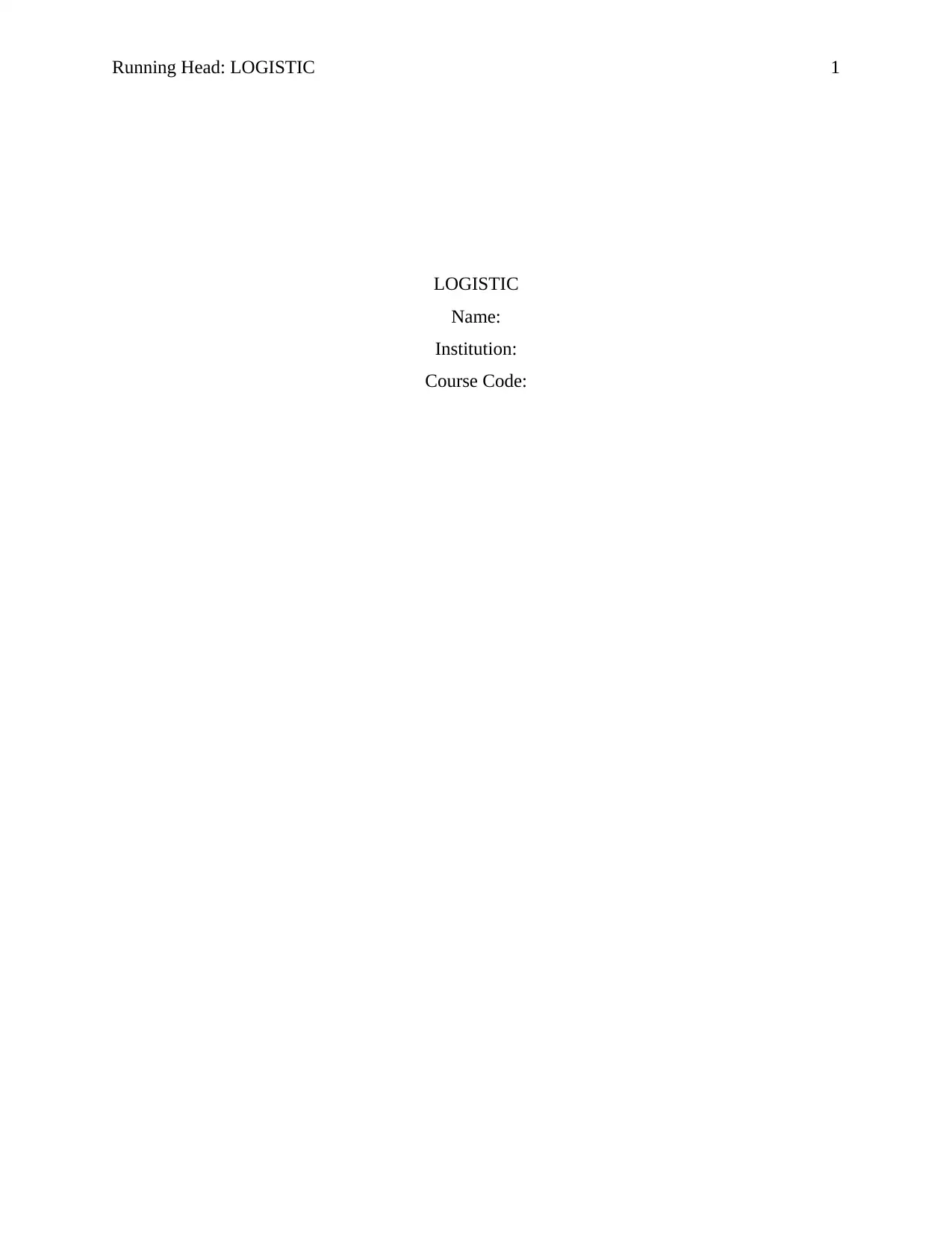
Running Head: LOGISTIC 1
LOGISTIC
Name:
Institution:
Course Code:
LOGISTIC
Name:
Institution:
Course Code:
Paraphrase This Document
Need a fresh take? Get an instant paraphrase of this document with our AI Paraphraser
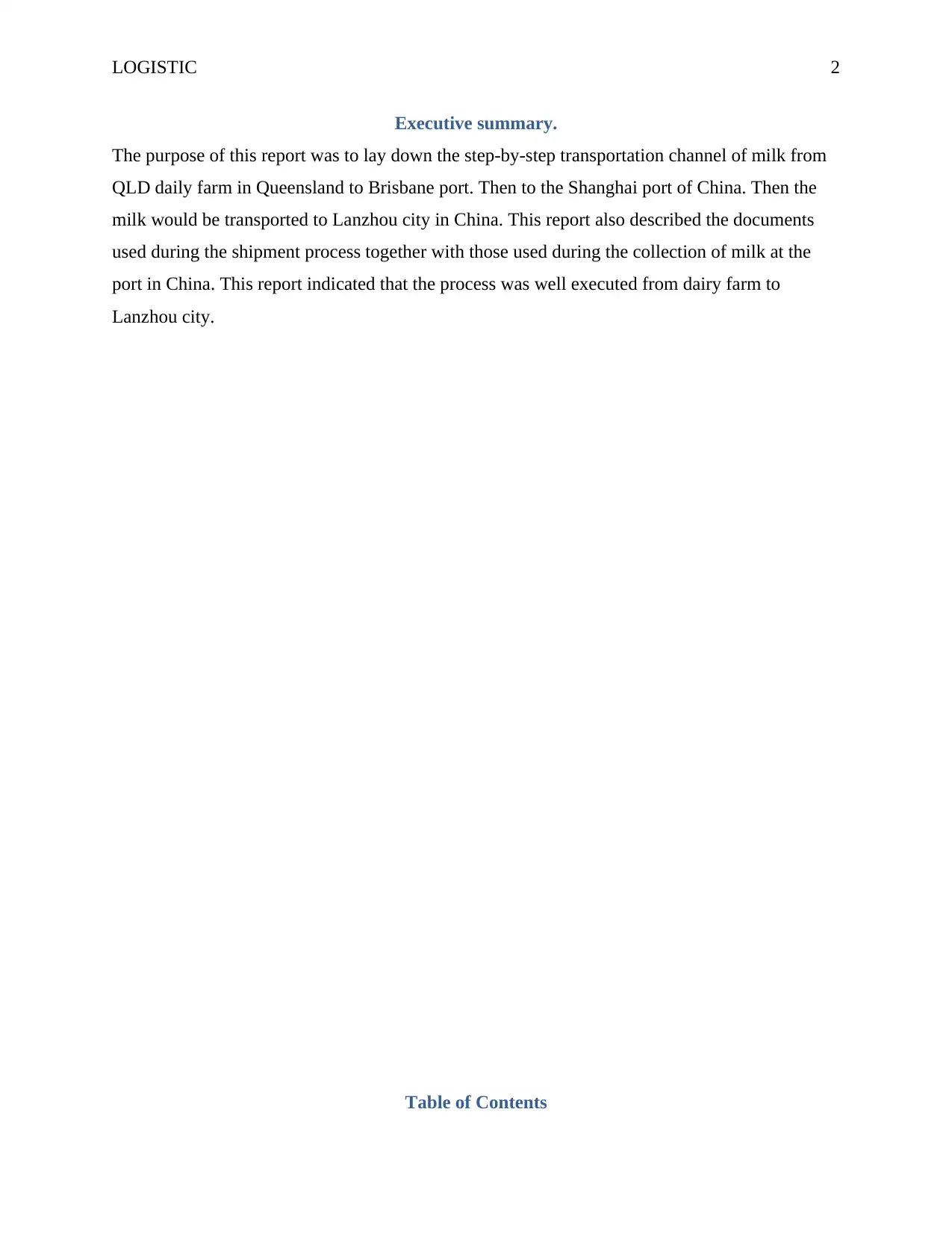
LOGISTIC 2
Executive summary.
The purpose of this report was to lay down the step-by-step transportation channel of milk from
QLD daily farm in Queensland to Brisbane port. Then to the Shanghai port of China. Then the
milk would be transported to Lanzhou city in China. This report also described the documents
used during the shipment process together with those used during the collection of milk at the
port in China. This report indicated that the process was well executed from dairy farm to
Lanzhou city.
Table of Contents
Executive summary.
The purpose of this report was to lay down the step-by-step transportation channel of milk from
QLD daily farm in Queensland to Brisbane port. Then to the Shanghai port of China. Then the
milk would be transported to Lanzhou city in China. This report also described the documents
used during the shipment process together with those used during the collection of milk at the
port in China. This report indicated that the process was well executed from dairy farm to
Lanzhou city.
Table of Contents
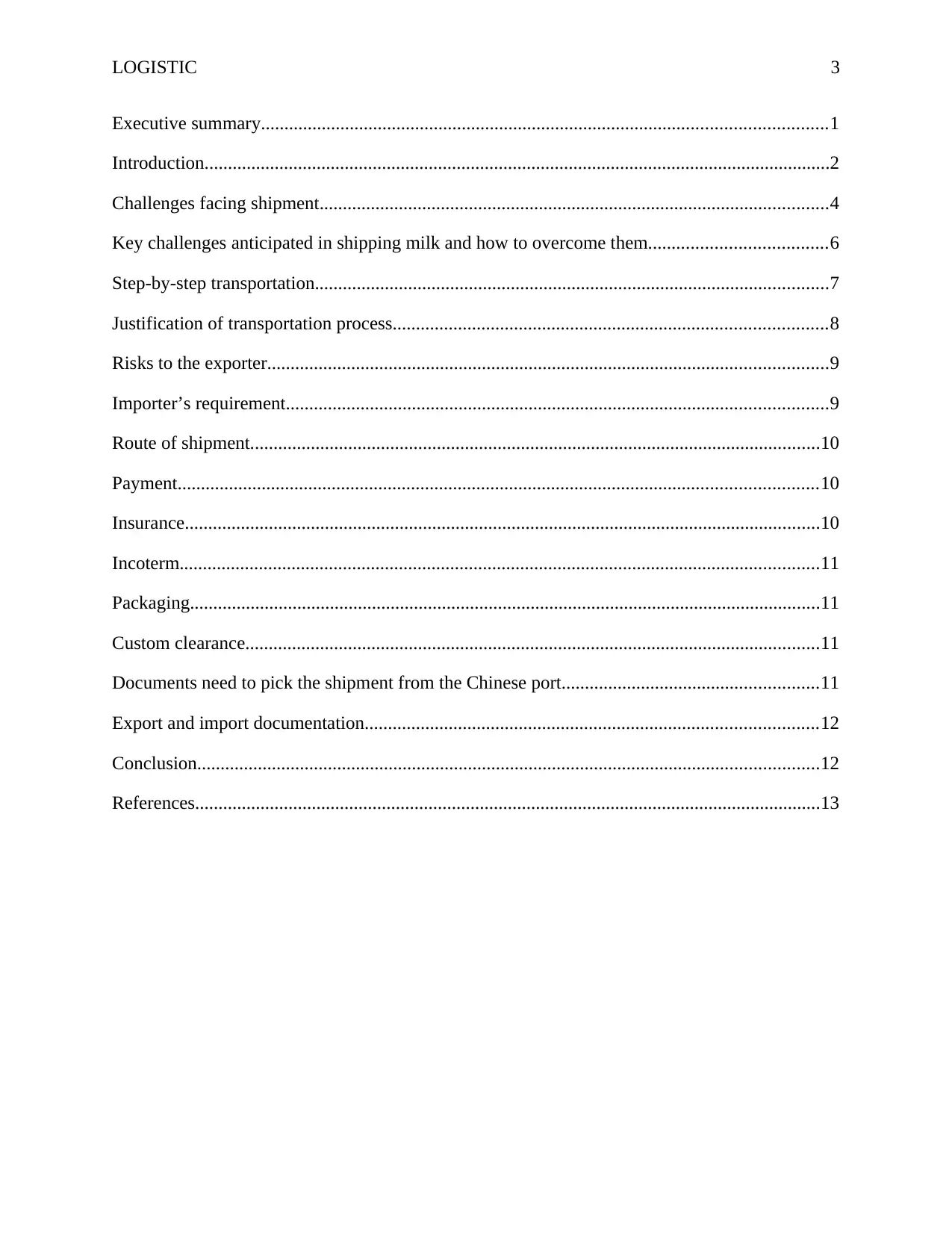
LOGISTIC 3
Executive summary.........................................................................................................................1
Introduction......................................................................................................................................2
Challenges facing shipment.............................................................................................................4
Key challenges anticipated in shipping milk and how to overcome them......................................6
Step-by-step transportation..............................................................................................................7
Justification of transportation process.............................................................................................8
Risks to the exporter........................................................................................................................9
Importer’s requirement....................................................................................................................9
Route of shipment..........................................................................................................................10
Payment.........................................................................................................................................10
Insurance........................................................................................................................................10
Incoterm.........................................................................................................................................11
Packaging.......................................................................................................................................11
Custom clearance...........................................................................................................................11
Documents need to pick the shipment from the Chinese port.......................................................11
Export and import documentation.................................................................................................12
Conclusion.....................................................................................................................................12
References......................................................................................................................................13
Executive summary.........................................................................................................................1
Introduction......................................................................................................................................2
Challenges facing shipment.............................................................................................................4
Key challenges anticipated in shipping milk and how to overcome them......................................6
Step-by-step transportation..............................................................................................................7
Justification of transportation process.............................................................................................8
Risks to the exporter........................................................................................................................9
Importer’s requirement....................................................................................................................9
Route of shipment..........................................................................................................................10
Payment.........................................................................................................................................10
Insurance........................................................................................................................................10
Incoterm.........................................................................................................................................11
Packaging.......................................................................................................................................11
Custom clearance...........................................................................................................................11
Documents need to pick the shipment from the Chinese port.......................................................11
Export and import documentation.................................................................................................12
Conclusion.....................................................................................................................................12
References......................................................................................................................................13
⊘ This is a preview!⊘
Do you want full access?
Subscribe today to unlock all pages.

Trusted by 1+ million students worldwide
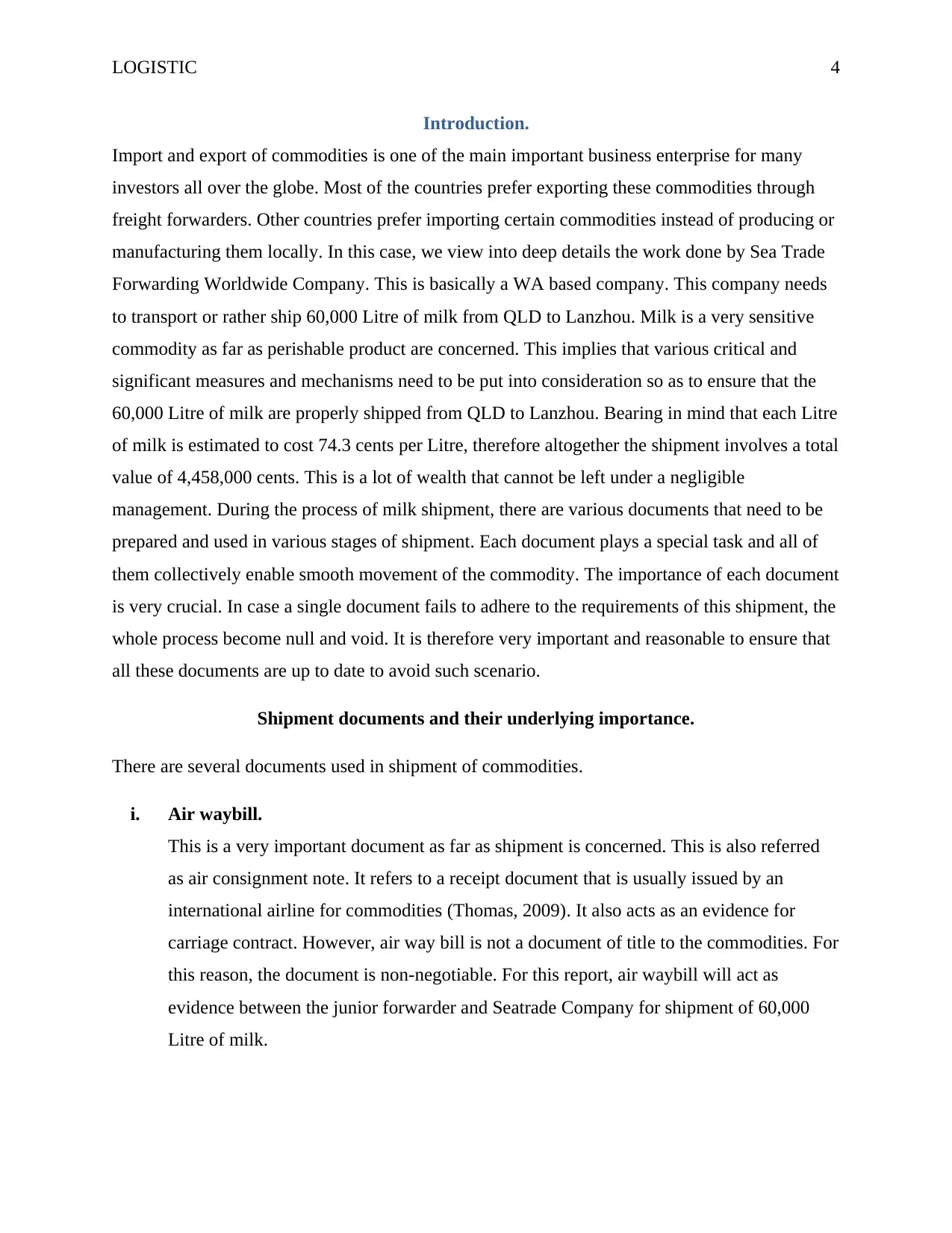
LOGISTIC 4
Introduction.
Import and export of commodities is one of the main important business enterprise for many
investors all over the globe. Most of the countries prefer exporting these commodities through
freight forwarders. Other countries prefer importing certain commodities instead of producing or
manufacturing them locally. In this case, we view into deep details the work done by Sea Trade
Forwarding Worldwide Company. This is basically a WA based company. This company needs
to transport or rather ship 60,000 Litre of milk from QLD to Lanzhou. Milk is a very sensitive
commodity as far as perishable product are concerned. This implies that various critical and
significant measures and mechanisms need to be put into consideration so as to ensure that the
60,000 Litre of milk are properly shipped from QLD to Lanzhou. Bearing in mind that each Litre
of milk is estimated to cost 74.3 cents per Litre, therefore altogether the shipment involves a total
value of 4,458,000 cents. This is a lot of wealth that cannot be left under a negligible
management. During the process of milk shipment, there are various documents that need to be
prepared and used in various stages of shipment. Each document plays a special task and all of
them collectively enable smooth movement of the commodity. The importance of each document
is very crucial. In case a single document fails to adhere to the requirements of this shipment, the
whole process become null and void. It is therefore very important and reasonable to ensure that
all these documents are up to date to avoid such scenario.
Shipment documents and their underlying importance.
There are several documents used in shipment of commodities.
i. Air waybill.
This is a very important document as far as shipment is concerned. This is also referred
as air consignment note. It refers to a receipt document that is usually issued by an
international airline for commodities (Thomas, 2009). It also acts as an evidence for
carriage contract. However, air way bill is not a document of title to the commodities. For
this reason, the document is non-negotiable. For this report, air waybill will act as
evidence between the junior forwarder and Seatrade Company for shipment of 60,000
Litre of milk.
Introduction.
Import and export of commodities is one of the main important business enterprise for many
investors all over the globe. Most of the countries prefer exporting these commodities through
freight forwarders. Other countries prefer importing certain commodities instead of producing or
manufacturing them locally. In this case, we view into deep details the work done by Sea Trade
Forwarding Worldwide Company. This is basically a WA based company. This company needs
to transport or rather ship 60,000 Litre of milk from QLD to Lanzhou. Milk is a very sensitive
commodity as far as perishable product are concerned. This implies that various critical and
significant measures and mechanisms need to be put into consideration so as to ensure that the
60,000 Litre of milk are properly shipped from QLD to Lanzhou. Bearing in mind that each Litre
of milk is estimated to cost 74.3 cents per Litre, therefore altogether the shipment involves a total
value of 4,458,000 cents. This is a lot of wealth that cannot be left under a negligible
management. During the process of milk shipment, there are various documents that need to be
prepared and used in various stages of shipment. Each document plays a special task and all of
them collectively enable smooth movement of the commodity. The importance of each document
is very crucial. In case a single document fails to adhere to the requirements of this shipment, the
whole process become null and void. It is therefore very important and reasonable to ensure that
all these documents are up to date to avoid such scenario.
Shipment documents and their underlying importance.
There are several documents used in shipment of commodities.
i. Air waybill.
This is a very important document as far as shipment is concerned. This is also referred
as air consignment note. It refers to a receipt document that is usually issued by an
international airline for commodities (Thomas, 2009). It also acts as an evidence for
carriage contract. However, air way bill is not a document of title to the commodities. For
this reason, the document is non-negotiable. For this report, air waybill will act as
evidence between the junior forwarder and Seatrade Company for shipment of 60,000
Litre of milk.
Paraphrase This Document
Need a fresh take? Get an instant paraphrase of this document with our AI Paraphraser
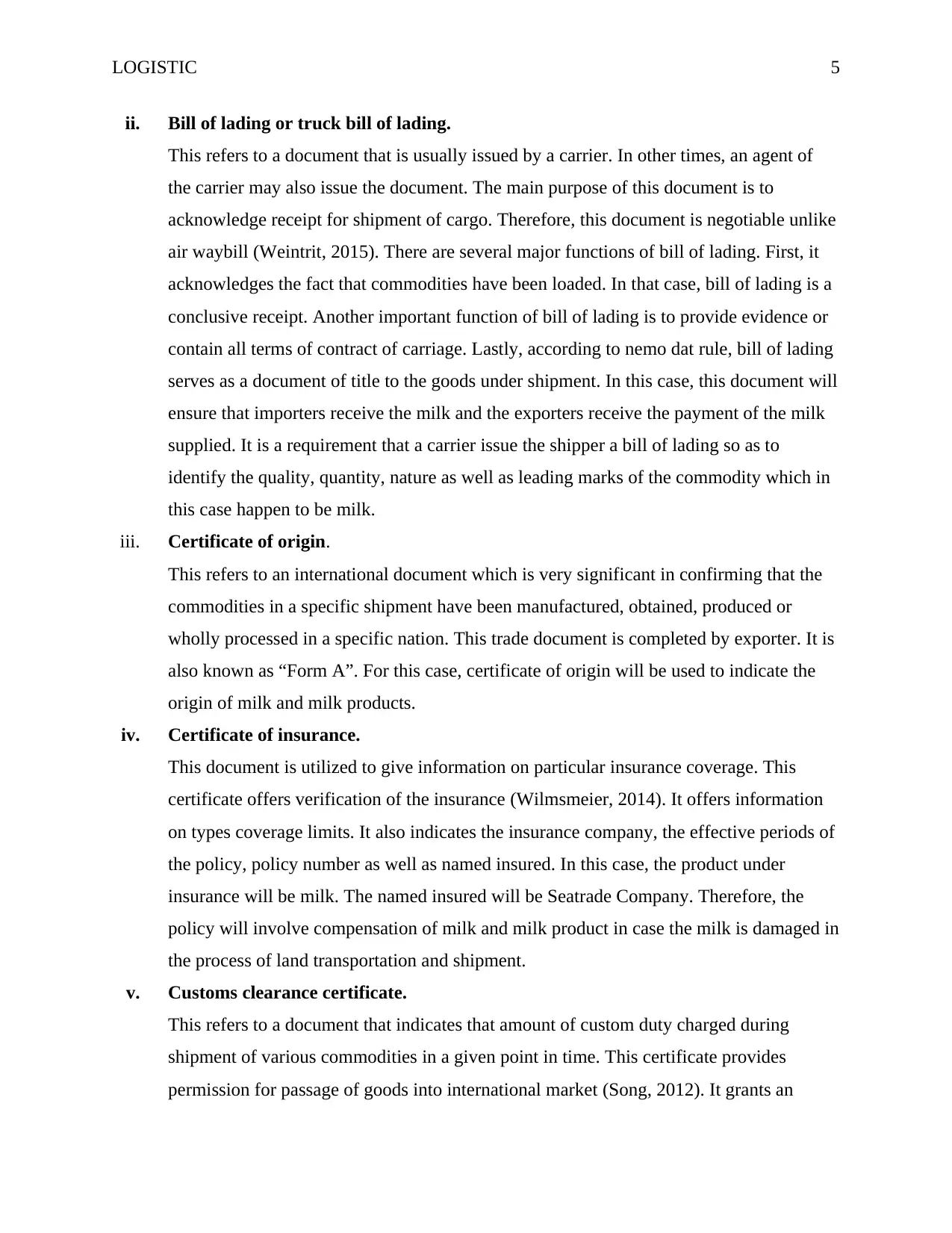
LOGISTIC 5
ii. Bill of lading or truck bill of lading.
This refers to a document that is usually issued by a carrier. In other times, an agent of
the carrier may also issue the document. The main purpose of this document is to
acknowledge receipt for shipment of cargo. Therefore, this document is negotiable unlike
air waybill (Weintrit, 2015). There are several major functions of bill of lading. First, it
acknowledges the fact that commodities have been loaded. In that case, bill of lading is a
conclusive receipt. Another important function of bill of lading is to provide evidence or
contain all terms of contract of carriage. Lastly, according to nemo dat rule, bill of lading
serves as a document of title to the goods under shipment. In this case, this document will
ensure that importers receive the milk and the exporters receive the payment of the milk
supplied. It is a requirement that a carrier issue the shipper a bill of lading so as to
identify the quality, quantity, nature as well as leading marks of the commodity which in
this case happen to be milk.
iii. Certificate of origin.
This refers to an international document which is very significant in confirming that the
commodities in a specific shipment have been manufactured, obtained, produced or
wholly processed in a specific nation. This trade document is completed by exporter. It is
also known as “Form A”. For this case, certificate of origin will be used to indicate the
origin of milk and milk products.
iv. Certificate of insurance.
This document is utilized to give information on particular insurance coverage. This
certificate offers verification of the insurance (Wilmsmeier, 2014). It offers information
on types coverage limits. It also indicates the insurance company, the effective periods of
the policy, policy number as well as named insured. In this case, the product under
insurance will be milk. The named insured will be Seatrade Company. Therefore, the
policy will involve compensation of milk and milk product in case the milk is damaged in
the process of land transportation and shipment.
v. Customs clearance certificate.
This refers to a document that indicates that amount of custom duty charged during
shipment of various commodities in a given point in time. This certificate provides
permission for passage of goods into international market (Song, 2012). It grants an
ii. Bill of lading or truck bill of lading.
This refers to a document that is usually issued by a carrier. In other times, an agent of
the carrier may also issue the document. The main purpose of this document is to
acknowledge receipt for shipment of cargo. Therefore, this document is negotiable unlike
air waybill (Weintrit, 2015). There are several major functions of bill of lading. First, it
acknowledges the fact that commodities have been loaded. In that case, bill of lading is a
conclusive receipt. Another important function of bill of lading is to provide evidence or
contain all terms of contract of carriage. Lastly, according to nemo dat rule, bill of lading
serves as a document of title to the goods under shipment. In this case, this document will
ensure that importers receive the milk and the exporters receive the payment of the milk
supplied. It is a requirement that a carrier issue the shipper a bill of lading so as to
identify the quality, quantity, nature as well as leading marks of the commodity which in
this case happen to be milk.
iii. Certificate of origin.
This refers to an international document which is very significant in confirming that the
commodities in a specific shipment have been manufactured, obtained, produced or
wholly processed in a specific nation. This trade document is completed by exporter. It is
also known as “Form A”. For this case, certificate of origin will be used to indicate the
origin of milk and milk products.
iv. Certificate of insurance.
This document is utilized to give information on particular insurance coverage. This
certificate offers verification of the insurance (Wilmsmeier, 2014). It offers information
on types coverage limits. It also indicates the insurance company, the effective periods of
the policy, policy number as well as named insured. In this case, the product under
insurance will be milk. The named insured will be Seatrade Company. Therefore, the
policy will involve compensation of milk and milk product in case the milk is damaged in
the process of land transportation and shipment.
v. Customs clearance certificate.
This refers to a document that indicates that amount of custom duty charged during
shipment of various commodities in a given point in time. This certificate provides
permission for passage of goods into international market (Song, 2012). It grants an
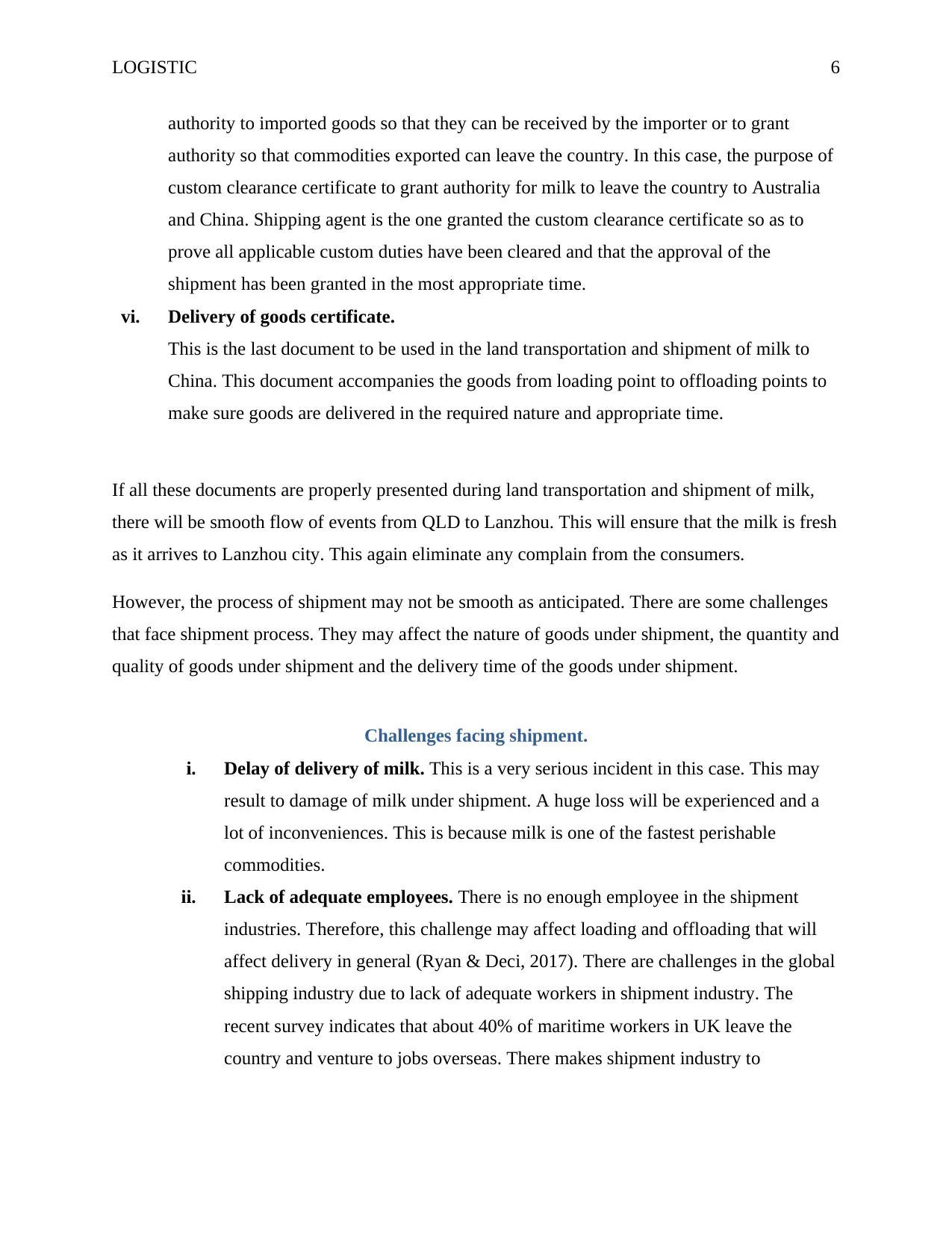
LOGISTIC 6
authority to imported goods so that they can be received by the importer or to grant
authority so that commodities exported can leave the country. In this case, the purpose of
custom clearance certificate to grant authority for milk to leave the country to Australia
and China. Shipping agent is the one granted the custom clearance certificate so as to
prove all applicable custom duties have been cleared and that the approval of the
shipment has been granted in the most appropriate time.
vi. Delivery of goods certificate.
This is the last document to be used in the land transportation and shipment of milk to
China. This document accompanies the goods from loading point to offloading points to
make sure goods are delivered in the required nature and appropriate time.
If all these documents are properly presented during land transportation and shipment of milk,
there will be smooth flow of events from QLD to Lanzhou. This will ensure that the milk is fresh
as it arrives to Lanzhou city. This again eliminate any complain from the consumers.
However, the process of shipment may not be smooth as anticipated. There are some challenges
that face shipment process. They may affect the nature of goods under shipment, the quantity and
quality of goods under shipment and the delivery time of the goods under shipment.
Challenges facing shipment.
i. Delay of delivery of milk. This is a very serious incident in this case. This may
result to damage of milk under shipment. A huge loss will be experienced and a
lot of inconveniences. This is because milk is one of the fastest perishable
commodities.
ii. Lack of adequate employees. There is no enough employee in the shipment
industries. Therefore, this challenge may affect loading and offloading that will
affect delivery in general (Ryan & Deci, 2017). There are challenges in the global
shipping industry due to lack of adequate workers in shipment industry. The
recent survey indicates that about 40% of maritime workers in UK leave the
country and venture to jobs overseas. There makes shipment industry to
authority to imported goods so that they can be received by the importer or to grant
authority so that commodities exported can leave the country. In this case, the purpose of
custom clearance certificate to grant authority for milk to leave the country to Australia
and China. Shipping agent is the one granted the custom clearance certificate so as to
prove all applicable custom duties have been cleared and that the approval of the
shipment has been granted in the most appropriate time.
vi. Delivery of goods certificate.
This is the last document to be used in the land transportation and shipment of milk to
China. This document accompanies the goods from loading point to offloading points to
make sure goods are delivered in the required nature and appropriate time.
If all these documents are properly presented during land transportation and shipment of milk,
there will be smooth flow of events from QLD to Lanzhou. This will ensure that the milk is fresh
as it arrives to Lanzhou city. This again eliminate any complain from the consumers.
However, the process of shipment may not be smooth as anticipated. There are some challenges
that face shipment process. They may affect the nature of goods under shipment, the quantity and
quality of goods under shipment and the delivery time of the goods under shipment.
Challenges facing shipment.
i. Delay of delivery of milk. This is a very serious incident in this case. This may
result to damage of milk under shipment. A huge loss will be experienced and a
lot of inconveniences. This is because milk is one of the fastest perishable
commodities.
ii. Lack of adequate employees. There is no enough employee in the shipment
industries. Therefore, this challenge may affect loading and offloading that will
affect delivery in general (Ryan & Deci, 2017). There are challenges in the global
shipping industry due to lack of adequate workers in shipment industry. The
recent survey indicates that about 40% of maritime workers in UK leave the
country and venture to jobs overseas. There makes shipment industry to
⊘ This is a preview!⊘
Do you want full access?
Subscribe today to unlock all pages.

Trusted by 1+ million students worldwide
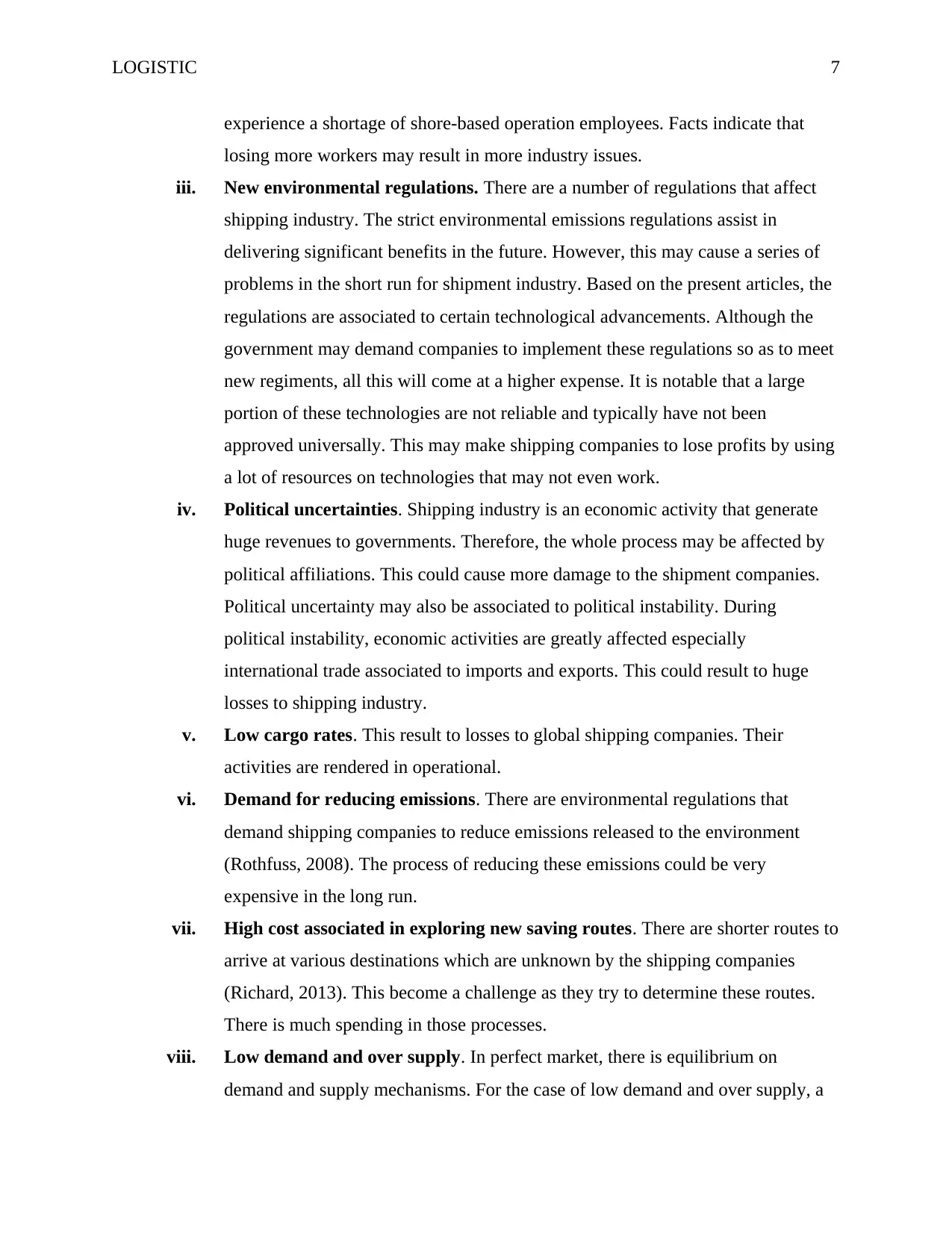
LOGISTIC 7
experience a shortage of shore-based operation employees. Facts indicate that
losing more workers may result in more industry issues.
iii. New environmental regulations. There are a number of regulations that affect
shipping industry. The strict environmental emissions regulations assist in
delivering significant benefits in the future. However, this may cause a series of
problems in the short run for shipment industry. Based on the present articles, the
regulations are associated to certain technological advancements. Although the
government may demand companies to implement these regulations so as to meet
new regiments, all this will come at a higher expense. It is notable that a large
portion of these technologies are not reliable and typically have not been
approved universally. This may make shipping companies to lose profits by using
a lot of resources on technologies that may not even work.
iv. Political uncertainties. Shipping industry is an economic activity that generate
huge revenues to governments. Therefore, the whole process may be affected by
political affiliations. This could cause more damage to the shipment companies.
Political uncertainty may also be associated to political instability. During
political instability, economic activities are greatly affected especially
international trade associated to imports and exports. This could result to huge
losses to shipping industry.
v. Low cargo rates. This result to losses to global shipping companies. Their
activities are rendered in operational.
vi. Demand for reducing emissions. There are environmental regulations that
demand shipping companies to reduce emissions released to the environment
(Rothfuss, 2008). The process of reducing these emissions could be very
expensive in the long run.
vii. High cost associated in exploring new saving routes. There are shorter routes to
arrive at various destinations which are unknown by the shipping companies
(Richard, 2013). This become a challenge as they try to determine these routes.
There is much spending in those processes.
viii. Low demand and over supply. In perfect market, there is equilibrium on
demand and supply mechanisms. For the case of low demand and over supply, a
experience a shortage of shore-based operation employees. Facts indicate that
losing more workers may result in more industry issues.
iii. New environmental regulations. There are a number of regulations that affect
shipping industry. The strict environmental emissions regulations assist in
delivering significant benefits in the future. However, this may cause a series of
problems in the short run for shipment industry. Based on the present articles, the
regulations are associated to certain technological advancements. Although the
government may demand companies to implement these regulations so as to meet
new regiments, all this will come at a higher expense. It is notable that a large
portion of these technologies are not reliable and typically have not been
approved universally. This may make shipping companies to lose profits by using
a lot of resources on technologies that may not even work.
iv. Political uncertainties. Shipping industry is an economic activity that generate
huge revenues to governments. Therefore, the whole process may be affected by
political affiliations. This could cause more damage to the shipment companies.
Political uncertainty may also be associated to political instability. During
political instability, economic activities are greatly affected especially
international trade associated to imports and exports. This could result to huge
losses to shipping industry.
v. Low cargo rates. This result to losses to global shipping companies. Their
activities are rendered in operational.
vi. Demand for reducing emissions. There are environmental regulations that
demand shipping companies to reduce emissions released to the environment
(Rothfuss, 2008). The process of reducing these emissions could be very
expensive in the long run.
vii. High cost associated in exploring new saving routes. There are shorter routes to
arrive at various destinations which are unknown by the shipping companies
(Richard, 2013). This become a challenge as they try to determine these routes.
There is much spending in those processes.
viii. Low demand and over supply. In perfect market, there is equilibrium on
demand and supply mechanisms. For the case of low demand and over supply, a
Paraphrase This Document
Need a fresh take? Get an instant paraphrase of this document with our AI Paraphraser
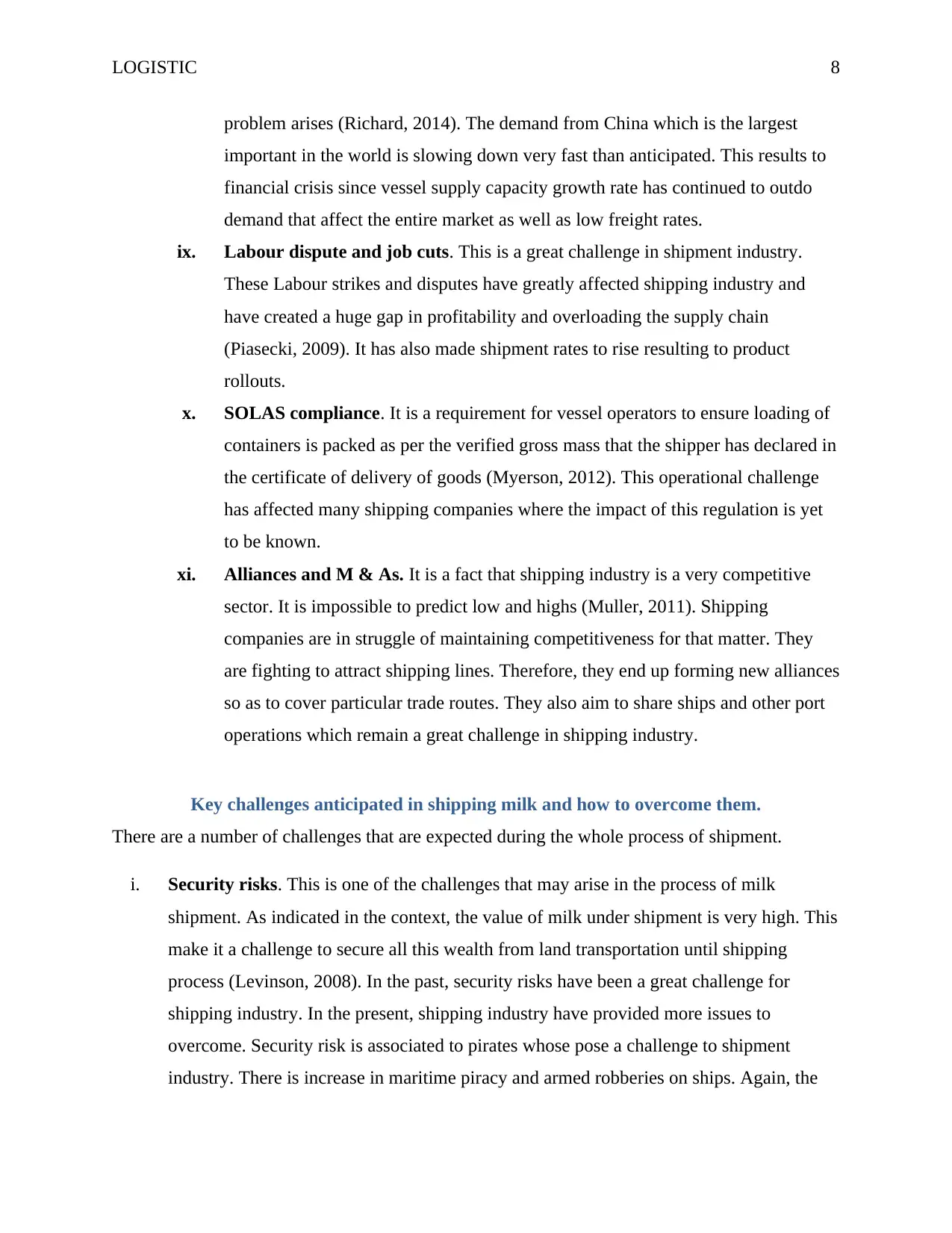
LOGISTIC 8
problem arises (Richard, 2014). The demand from China which is the largest
important in the world is slowing down very fast than anticipated. This results to
financial crisis since vessel supply capacity growth rate has continued to outdo
demand that affect the entire market as well as low freight rates.
ix. Labour dispute and job cuts. This is a great challenge in shipment industry.
These Labour strikes and disputes have greatly affected shipping industry and
have created a huge gap in profitability and overloading the supply chain
(Piasecki, 2009). It has also made shipment rates to rise resulting to product
rollouts.
x. SOLAS compliance. It is a requirement for vessel operators to ensure loading of
containers is packed as per the verified gross mass that the shipper has declared in
the certificate of delivery of goods (Myerson, 2012). This operational challenge
has affected many shipping companies where the impact of this regulation is yet
to be known.
xi. Alliances and M & As. It is a fact that shipping industry is a very competitive
sector. It is impossible to predict low and highs (Muller, 2011). Shipping
companies are in struggle of maintaining competitiveness for that matter. They
are fighting to attract shipping lines. Therefore, they end up forming new alliances
so as to cover particular trade routes. They also aim to share ships and other port
operations which remain a great challenge in shipping industry.
Key challenges anticipated in shipping milk and how to overcome them.
There are a number of challenges that are expected during the whole process of shipment.
i. Security risks. This is one of the challenges that may arise in the process of milk
shipment. As indicated in the context, the value of milk under shipment is very high. This
make it a challenge to secure all this wealth from land transportation until shipping
process (Levinson, 2008). In the past, security risks have been a great challenge for
shipping industry. In the present, shipping industry have provided more issues to
overcome. Security risk is associated to pirates whose pose a challenge to shipment
industry. There is increase in maritime piracy and armed robberies on ships. Again, the
problem arises (Richard, 2014). The demand from China which is the largest
important in the world is slowing down very fast than anticipated. This results to
financial crisis since vessel supply capacity growth rate has continued to outdo
demand that affect the entire market as well as low freight rates.
ix. Labour dispute and job cuts. This is a great challenge in shipment industry.
These Labour strikes and disputes have greatly affected shipping industry and
have created a huge gap in profitability and overloading the supply chain
(Piasecki, 2009). It has also made shipment rates to rise resulting to product
rollouts.
x. SOLAS compliance. It is a requirement for vessel operators to ensure loading of
containers is packed as per the verified gross mass that the shipper has declared in
the certificate of delivery of goods (Myerson, 2012). This operational challenge
has affected many shipping companies where the impact of this regulation is yet
to be known.
xi. Alliances and M & As. It is a fact that shipping industry is a very competitive
sector. It is impossible to predict low and highs (Muller, 2011). Shipping
companies are in struggle of maintaining competitiveness for that matter. They
are fighting to attract shipping lines. Therefore, they end up forming new alliances
so as to cover particular trade routes. They also aim to share ships and other port
operations which remain a great challenge in shipping industry.
Key challenges anticipated in shipping milk and how to overcome them.
There are a number of challenges that are expected during the whole process of shipment.
i. Security risks. This is one of the challenges that may arise in the process of milk
shipment. As indicated in the context, the value of milk under shipment is very high. This
make it a challenge to secure all this wealth from land transportation until shipping
process (Levinson, 2008). In the past, security risks have been a great challenge for
shipping industry. In the present, shipping industry have provided more issues to
overcome. Security risk is associated to pirates whose pose a challenge to shipment
industry. There is increase in maritime piracy and armed robberies on ships. Again, the
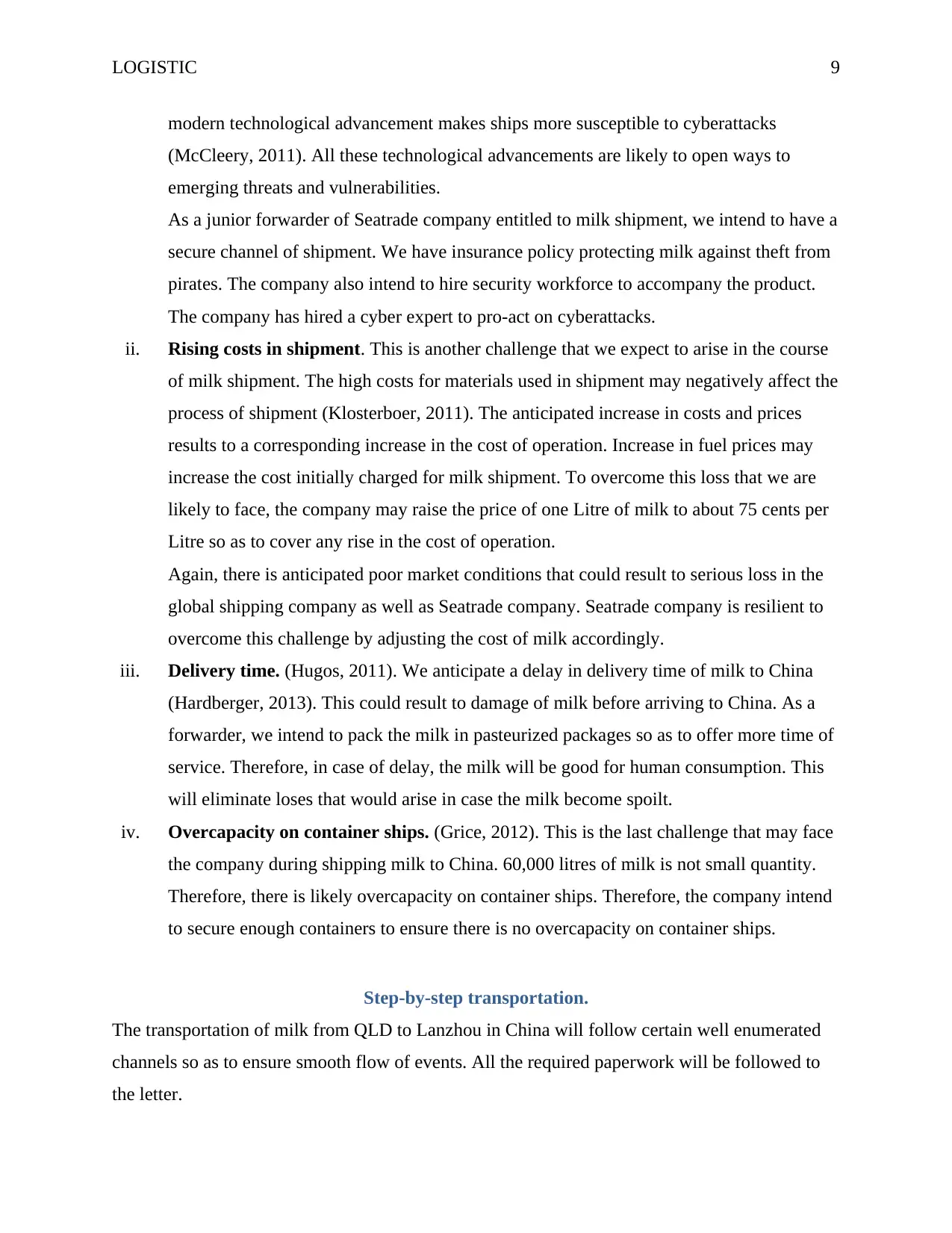
LOGISTIC 9
modern technological advancement makes ships more susceptible to cyberattacks
(McCleery, 2011). All these technological advancements are likely to open ways to
emerging threats and vulnerabilities.
As a junior forwarder of Seatrade company entitled to milk shipment, we intend to have a
secure channel of shipment. We have insurance policy protecting milk against theft from
pirates. The company also intend to hire security workforce to accompany the product.
The company has hired a cyber expert to pro-act on cyberattacks.
ii. Rising costs in shipment. This is another challenge that we expect to arise in the course
of milk shipment. The high costs for materials used in shipment may negatively affect the
process of shipment (Klosterboer, 2011). The anticipated increase in costs and prices
results to a corresponding increase in the cost of operation. Increase in fuel prices may
increase the cost initially charged for milk shipment. To overcome this loss that we are
likely to face, the company may raise the price of one Litre of milk to about 75 cents per
Litre so as to cover any rise in the cost of operation.
Again, there is anticipated poor market conditions that could result to serious loss in the
global shipping company as well as Seatrade company. Seatrade company is resilient to
overcome this challenge by adjusting the cost of milk accordingly.
iii. Delivery time. (Hugos, 2011). We anticipate a delay in delivery time of milk to China
(Hardberger, 2013). This could result to damage of milk before arriving to China. As a
forwarder, we intend to pack the milk in pasteurized packages so as to offer more time of
service. Therefore, in case of delay, the milk will be good for human consumption. This
will eliminate loses that would arise in case the milk become spoilt.
iv. Overcapacity on container ships. (Grice, 2012). This is the last challenge that may face
the company during shipping milk to China. 60,000 litres of milk is not small quantity.
Therefore, there is likely overcapacity on container ships. Therefore, the company intend
to secure enough containers to ensure there is no overcapacity on container ships.
Step-by-step transportation.
The transportation of milk from QLD to Lanzhou in China will follow certain well enumerated
channels so as to ensure smooth flow of events. All the required paperwork will be followed to
the letter.
modern technological advancement makes ships more susceptible to cyberattacks
(McCleery, 2011). All these technological advancements are likely to open ways to
emerging threats and vulnerabilities.
As a junior forwarder of Seatrade company entitled to milk shipment, we intend to have a
secure channel of shipment. We have insurance policy protecting milk against theft from
pirates. The company also intend to hire security workforce to accompany the product.
The company has hired a cyber expert to pro-act on cyberattacks.
ii. Rising costs in shipment. This is another challenge that we expect to arise in the course
of milk shipment. The high costs for materials used in shipment may negatively affect the
process of shipment (Klosterboer, 2011). The anticipated increase in costs and prices
results to a corresponding increase in the cost of operation. Increase in fuel prices may
increase the cost initially charged for milk shipment. To overcome this loss that we are
likely to face, the company may raise the price of one Litre of milk to about 75 cents per
Litre so as to cover any rise in the cost of operation.
Again, there is anticipated poor market conditions that could result to serious loss in the
global shipping company as well as Seatrade company. Seatrade company is resilient to
overcome this challenge by adjusting the cost of milk accordingly.
iii. Delivery time. (Hugos, 2011). We anticipate a delay in delivery time of milk to China
(Hardberger, 2013). This could result to damage of milk before arriving to China. As a
forwarder, we intend to pack the milk in pasteurized packages so as to offer more time of
service. Therefore, in case of delay, the milk will be good for human consumption. This
will eliminate loses that would arise in case the milk become spoilt.
iv. Overcapacity on container ships. (Grice, 2012). This is the last challenge that may face
the company during shipping milk to China. 60,000 litres of milk is not small quantity.
Therefore, there is likely overcapacity on container ships. Therefore, the company intend
to secure enough containers to ensure there is no overcapacity on container ships.
Step-by-step transportation.
The transportation of milk from QLD to Lanzhou in China will follow certain well enumerated
channels so as to ensure smooth flow of events. All the required paperwork will be followed to
the letter.
⊘ This is a preview!⊘
Do you want full access?
Subscribe today to unlock all pages.

Trusted by 1+ million students worldwide
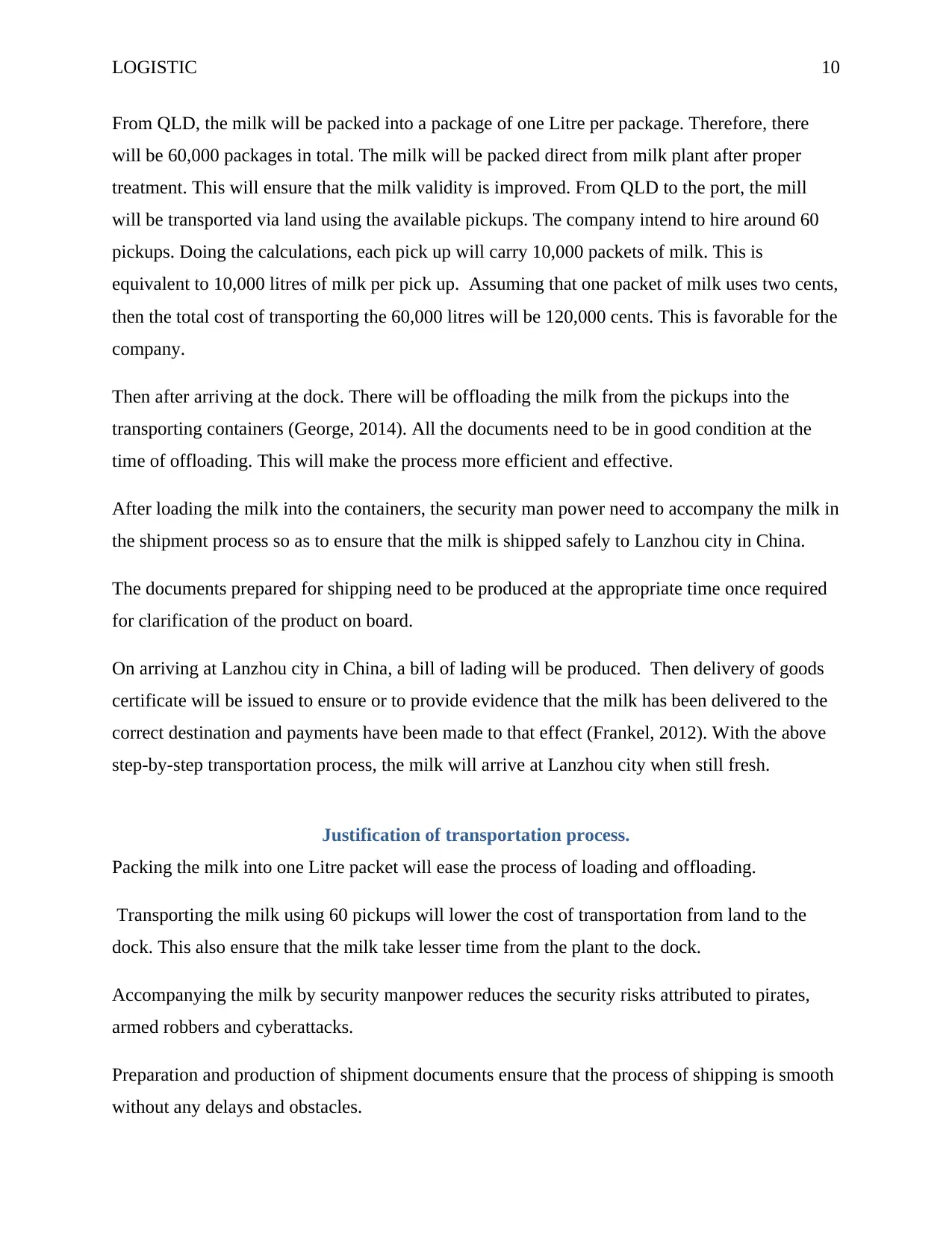
LOGISTIC 10
From QLD, the milk will be packed into a package of one Litre per package. Therefore, there
will be 60,000 packages in total. The milk will be packed direct from milk plant after proper
treatment. This will ensure that the milk validity is improved. From QLD to the port, the mill
will be transported via land using the available pickups. The company intend to hire around 60
pickups. Doing the calculations, each pick up will carry 10,000 packets of milk. This is
equivalent to 10,000 litres of milk per pick up. Assuming that one packet of milk uses two cents,
then the total cost of transporting the 60,000 litres will be 120,000 cents. This is favorable for the
company.
Then after arriving at the dock. There will be offloading the milk from the pickups into the
transporting containers (George, 2014). All the documents need to be in good condition at the
time of offloading. This will make the process more efficient and effective.
After loading the milk into the containers, the security man power need to accompany the milk in
the shipment process so as to ensure that the milk is shipped safely to Lanzhou city in China.
The documents prepared for shipping need to be produced at the appropriate time once required
for clarification of the product on board.
On arriving at Lanzhou city in China, a bill of lading will be produced. Then delivery of goods
certificate will be issued to ensure or to provide evidence that the milk has been delivered to the
correct destination and payments have been made to that effect (Frankel, 2012). With the above
step-by-step transportation process, the milk will arrive at Lanzhou city when still fresh.
Justification of transportation process.
Packing the milk into one Litre packet will ease the process of loading and offloading.
Transporting the milk using 60 pickups will lower the cost of transportation from land to the
dock. This also ensure that the milk take lesser time from the plant to the dock.
Accompanying the milk by security manpower reduces the security risks attributed to pirates,
armed robbers and cyberattacks.
Preparation and production of shipment documents ensure that the process of shipping is smooth
without any delays and obstacles.
From QLD, the milk will be packed into a package of one Litre per package. Therefore, there
will be 60,000 packages in total. The milk will be packed direct from milk plant after proper
treatment. This will ensure that the milk validity is improved. From QLD to the port, the mill
will be transported via land using the available pickups. The company intend to hire around 60
pickups. Doing the calculations, each pick up will carry 10,000 packets of milk. This is
equivalent to 10,000 litres of milk per pick up. Assuming that one packet of milk uses two cents,
then the total cost of transporting the 60,000 litres will be 120,000 cents. This is favorable for the
company.
Then after arriving at the dock. There will be offloading the milk from the pickups into the
transporting containers (George, 2014). All the documents need to be in good condition at the
time of offloading. This will make the process more efficient and effective.
After loading the milk into the containers, the security man power need to accompany the milk in
the shipment process so as to ensure that the milk is shipped safely to Lanzhou city in China.
The documents prepared for shipping need to be produced at the appropriate time once required
for clarification of the product on board.
On arriving at Lanzhou city in China, a bill of lading will be produced. Then delivery of goods
certificate will be issued to ensure or to provide evidence that the milk has been delivered to the
correct destination and payments have been made to that effect (Frankel, 2012). With the above
step-by-step transportation process, the milk will arrive at Lanzhou city when still fresh.
Justification of transportation process.
Packing the milk into one Litre packet will ease the process of loading and offloading.
Transporting the milk using 60 pickups will lower the cost of transportation from land to the
dock. This also ensure that the milk take lesser time from the plant to the dock.
Accompanying the milk by security manpower reduces the security risks attributed to pirates,
armed robbers and cyberattacks.
Preparation and production of shipment documents ensure that the process of shipping is smooth
without any delays and obstacles.
Paraphrase This Document
Need a fresh take? Get an instant paraphrase of this document with our AI Paraphraser
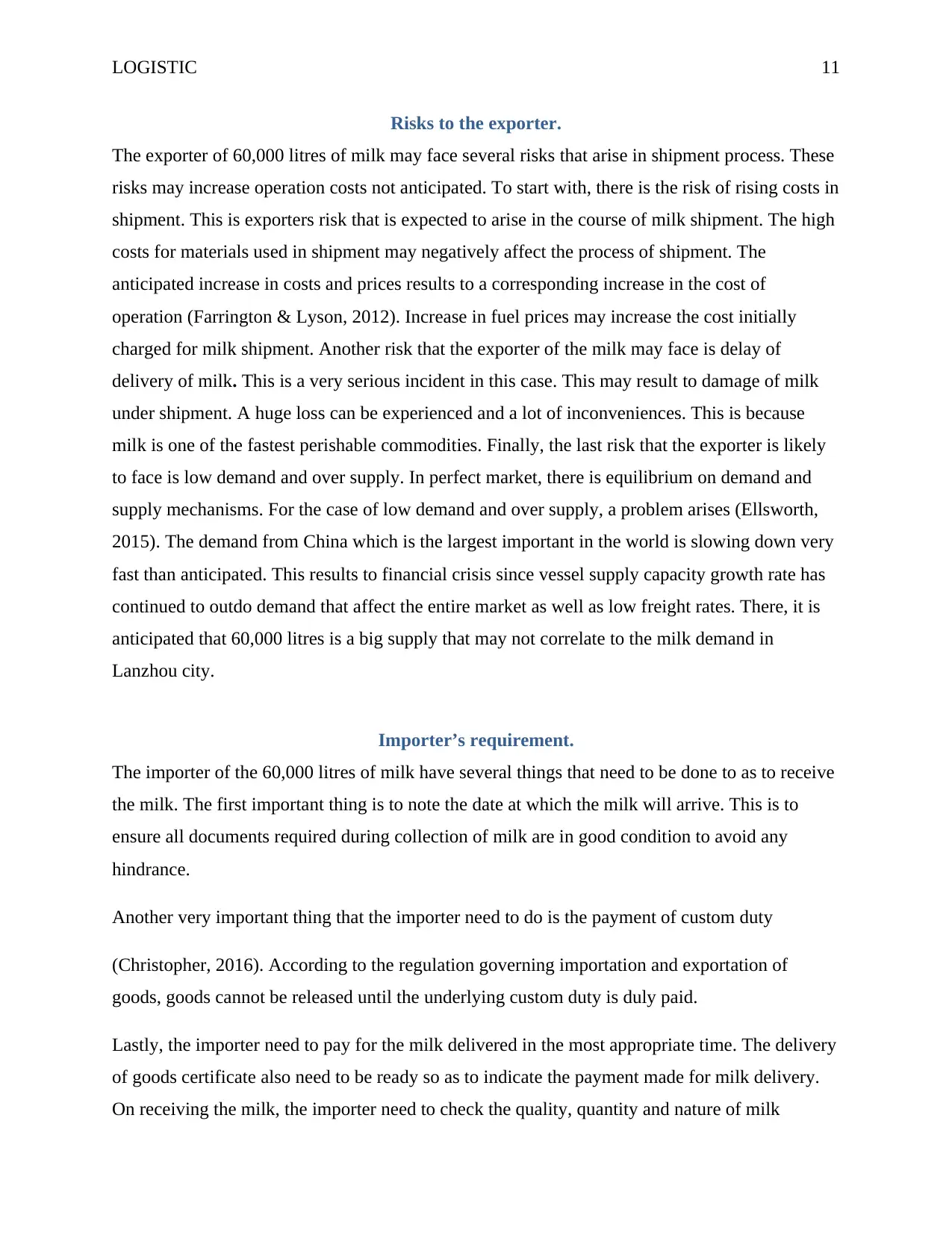
LOGISTIC 11
Risks to the exporter.
The exporter of 60,000 litres of milk may face several risks that arise in shipment process. These
risks may increase operation costs not anticipated. To start with, there is the risk of rising costs in
shipment. This is exporters risk that is expected to arise in the course of milk shipment. The high
costs for materials used in shipment may negatively affect the process of shipment. The
anticipated increase in costs and prices results to a corresponding increase in the cost of
operation (Farrington & Lyson, 2012). Increase in fuel prices may increase the cost initially
charged for milk shipment. Another risk that the exporter of the milk may face is delay of
delivery of milk. This is a very serious incident in this case. This may result to damage of milk
under shipment. A huge loss can be experienced and a lot of inconveniences. This is because
milk is one of the fastest perishable commodities. Finally, the last risk that the exporter is likely
to face is low demand and over supply. In perfect market, there is equilibrium on demand and
supply mechanisms. For the case of low demand and over supply, a problem arises (Ellsworth,
2015). The demand from China which is the largest important in the world is slowing down very
fast than anticipated. This results to financial crisis since vessel supply capacity growth rate has
continued to outdo demand that affect the entire market as well as low freight rates. There, it is
anticipated that 60,000 litres is a big supply that may not correlate to the milk demand in
Lanzhou city.
Importer’s requirement.
The importer of the 60,000 litres of milk have several things that need to be done to as to receive
the milk. The first important thing is to note the date at which the milk will arrive. This is to
ensure all documents required during collection of milk are in good condition to avoid any
hindrance.
Another very important thing that the importer need to do is the payment of custom duty
(Christopher, 2016). According to the regulation governing importation and exportation of
goods, goods cannot be released until the underlying custom duty is duly paid.
Lastly, the importer need to pay for the milk delivered in the most appropriate time. The delivery
of goods certificate also need to be ready so as to indicate the payment made for milk delivery.
On receiving the milk, the importer need to check the quality, quantity and nature of milk
Risks to the exporter.
The exporter of 60,000 litres of milk may face several risks that arise in shipment process. These
risks may increase operation costs not anticipated. To start with, there is the risk of rising costs in
shipment. This is exporters risk that is expected to arise in the course of milk shipment. The high
costs for materials used in shipment may negatively affect the process of shipment. The
anticipated increase in costs and prices results to a corresponding increase in the cost of
operation (Farrington & Lyson, 2012). Increase in fuel prices may increase the cost initially
charged for milk shipment. Another risk that the exporter of the milk may face is delay of
delivery of milk. This is a very serious incident in this case. This may result to damage of milk
under shipment. A huge loss can be experienced and a lot of inconveniences. This is because
milk is one of the fastest perishable commodities. Finally, the last risk that the exporter is likely
to face is low demand and over supply. In perfect market, there is equilibrium on demand and
supply mechanisms. For the case of low demand and over supply, a problem arises (Ellsworth,
2015). The demand from China which is the largest important in the world is slowing down very
fast than anticipated. This results to financial crisis since vessel supply capacity growth rate has
continued to outdo demand that affect the entire market as well as low freight rates. There, it is
anticipated that 60,000 litres is a big supply that may not correlate to the milk demand in
Lanzhou city.
Importer’s requirement.
The importer of the 60,000 litres of milk have several things that need to be done to as to receive
the milk. The first important thing is to note the date at which the milk will arrive. This is to
ensure all documents required during collection of milk are in good condition to avoid any
hindrance.
Another very important thing that the importer need to do is the payment of custom duty
(Christopher, 2016). According to the regulation governing importation and exportation of
goods, goods cannot be released until the underlying custom duty is duly paid.
Lastly, the importer need to pay for the milk delivered in the most appropriate time. The delivery
of goods certificate also need to be ready so as to indicate the payment made for milk delivery.
On receiving the milk, the importer need to check the quality, quantity and nature of milk
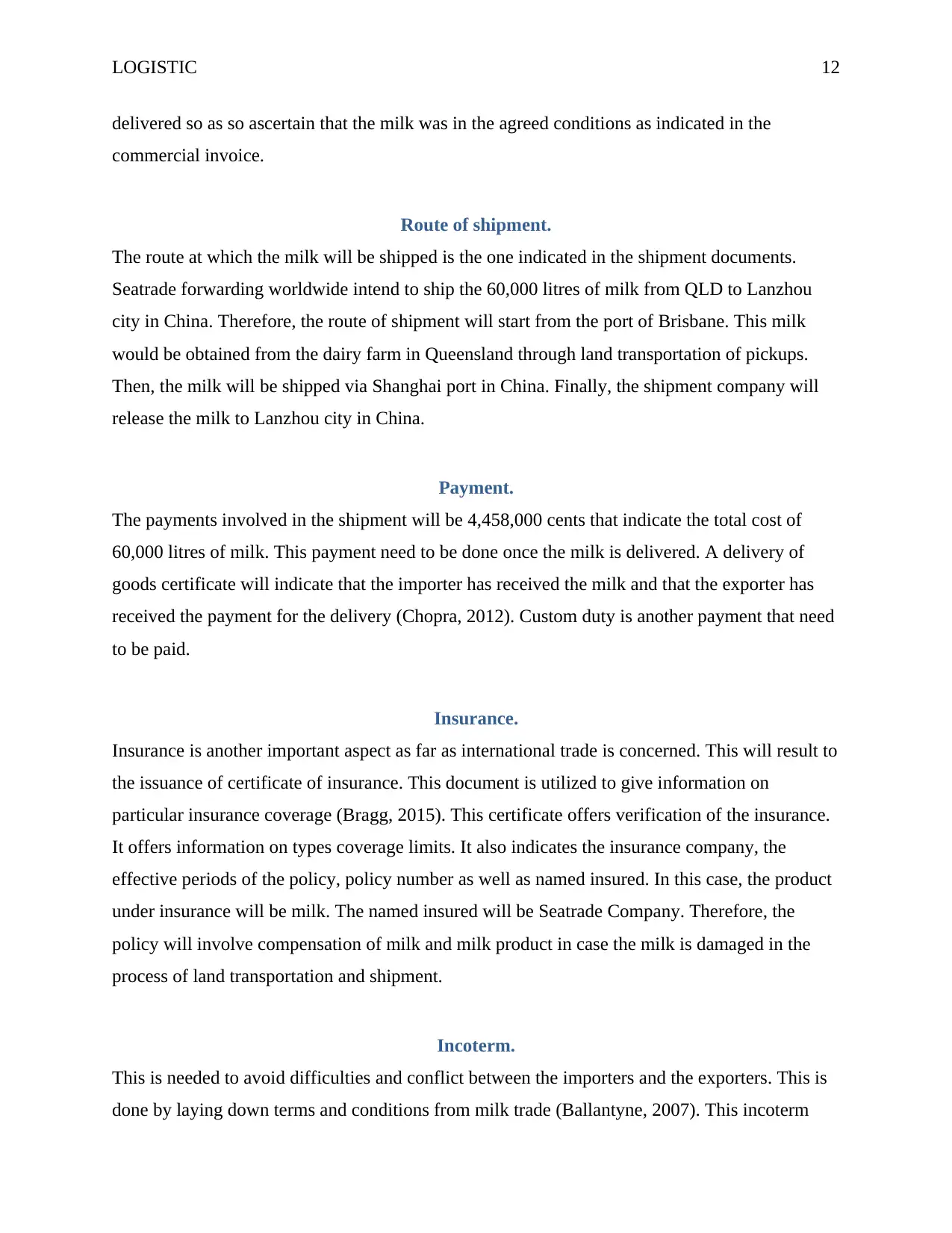
LOGISTIC 12
delivered so as so ascertain that the milk was in the agreed conditions as indicated in the
commercial invoice.
Route of shipment.
The route at which the milk will be shipped is the one indicated in the shipment documents.
Seatrade forwarding worldwide intend to ship the 60,000 litres of milk from QLD to Lanzhou
city in China. Therefore, the route of shipment will start from the port of Brisbane. This milk
would be obtained from the dairy farm in Queensland through land transportation of pickups.
Then, the milk will be shipped via Shanghai port in China. Finally, the shipment company will
release the milk to Lanzhou city in China.
Payment.
The payments involved in the shipment will be 4,458,000 cents that indicate the total cost of
60,000 litres of milk. This payment need to be done once the milk is delivered. A delivery of
goods certificate will indicate that the importer has received the milk and that the exporter has
received the payment for the delivery (Chopra, 2012). Custom duty is another payment that need
to be paid.
Insurance.
Insurance is another important aspect as far as international trade is concerned. This will result to
the issuance of certificate of insurance. This document is utilized to give information on
particular insurance coverage (Bragg, 2015). This certificate offers verification of the insurance.
It offers information on types coverage limits. It also indicates the insurance company, the
effective periods of the policy, policy number as well as named insured. In this case, the product
under insurance will be milk. The named insured will be Seatrade Company. Therefore, the
policy will involve compensation of milk and milk product in case the milk is damaged in the
process of land transportation and shipment.
Incoterm.
This is needed to avoid difficulties and conflict between the importers and the exporters. This is
done by laying down terms and conditions from milk trade (Ballantyne, 2007). This incoterm
delivered so as so ascertain that the milk was in the agreed conditions as indicated in the
commercial invoice.
Route of shipment.
The route at which the milk will be shipped is the one indicated in the shipment documents.
Seatrade forwarding worldwide intend to ship the 60,000 litres of milk from QLD to Lanzhou
city in China. Therefore, the route of shipment will start from the port of Brisbane. This milk
would be obtained from the dairy farm in Queensland through land transportation of pickups.
Then, the milk will be shipped via Shanghai port in China. Finally, the shipment company will
release the milk to Lanzhou city in China.
Payment.
The payments involved in the shipment will be 4,458,000 cents that indicate the total cost of
60,000 litres of milk. This payment need to be done once the milk is delivered. A delivery of
goods certificate will indicate that the importer has received the milk and that the exporter has
received the payment for the delivery (Chopra, 2012). Custom duty is another payment that need
to be paid.
Insurance.
Insurance is another important aspect as far as international trade is concerned. This will result to
the issuance of certificate of insurance. This document is utilized to give information on
particular insurance coverage (Bragg, 2015). This certificate offers verification of the insurance.
It offers information on types coverage limits. It also indicates the insurance company, the
effective periods of the policy, policy number as well as named insured. In this case, the product
under insurance will be milk. The named insured will be Seatrade Company. Therefore, the
policy will involve compensation of milk and milk product in case the milk is damaged in the
process of land transportation and shipment.
Incoterm.
This is needed to avoid difficulties and conflict between the importers and the exporters. This is
done by laying down terms and conditions from milk trade (Ballantyne, 2007). This incoterm
⊘ This is a preview!⊘
Do you want full access?
Subscribe today to unlock all pages.

Trusted by 1+ million students worldwide
1 out of 16
Related Documents
Your All-in-One AI-Powered Toolkit for Academic Success.
+13062052269
info@desklib.com
Available 24*7 on WhatsApp / Email
![[object Object]](/_next/static/media/star-bottom.7253800d.svg)
Unlock your academic potential
Copyright © 2020–2025 A2Z Services. All Rights Reserved. Developed and managed by ZUCOL.





